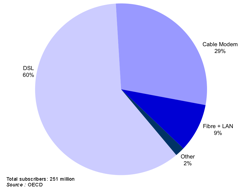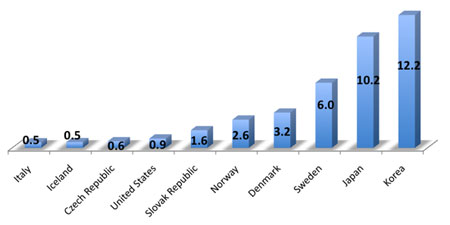While phone copper pairs may still be the main transmission media for DSL, new optical fiber-based deployments on a per capita basis are significantly increasing – particularly in Korea and Japan where penetration rates continue to uptrend steadily.
According to a report released on Thursday by Organisation for Economic Co-operation and Development [OECD], Fiber-based consumer broadband adoptions now account for 45% of all Japanese broadband subscriptions and 39% in Korea. Fiber, which has an almost unlimited transmission bandwidth, is overtaking DSL and Cable in both countries. Korea’s fibre penetration alone, is currently at about 12.2 per 100 inhabitants, which is higher than total broadband penetration in 5 OECD countries combined.
 As speed and capacity of the networks in digital space keeps rapidly advancing, so does its expansion. As result, subscribers have access to a much more robust network. The OECD notes, that the number of broadband subscribers in the OECD area reached 251 million by June 2008, an increase of 14% on year-over-year basis. Penetration rates increased as well to 21.3 subscriptions per 100 inhabitants.
As speed and capacity of the networks in digital space keeps rapidly advancing, so does its expansion. As result, subscribers have access to a much more robust network. The OECD notes, that the number of broadband subscribers in the OECD area reached 251 million by June 2008, an increase of 14% on year-over-year basis. Penetration rates increased as well to 21.3 subscriptions per 100 inhabitants.
DSL continues to remain the most popular technology with over 150 million subscriptions – claiming 60% market share. Cable modem comes in second with over 72 million subscriptions and 29% market share. Fibre-based connection is third with nearly 23 million subscriptions, comprising 9% of all broadband subscriptions in all 30 OECD countries.
In terms of broadband penetration rates Denmark, the Netherlands, Norway, Switzerland, Iceland, Sweden, Korea and Finland surpasses the 30 subscribers per 100 inhabitants threshold.
In recent years, three European nations: Denmark, Netherlands and Norway have rapidly increased their broadband subscribership. However, the strongest per-capita subscriber growth for this year was recorded in Luxembourg and Germany. Each country added more than 5 subscribers per 100 inhabitants.

Meanwhile, U.S. still remains the largest broadband market in the OECD with 75 million subscribers, consistently representing 30% of all broadband connections.
Photo: OECD
- Bulenox: Get 45% to 91% OFF ... Use Discount Code: UNO
- Risk Our Money Not Yours | Get 50% to 90% OFF ... Use Discount Code: MMBVBKSM
Disclaimer: This page contains affiliate links. If you choose to make a purchase after clicking a link, we may receive a commission at no additional cost to you. Thank you for your support!


Leave a Reply